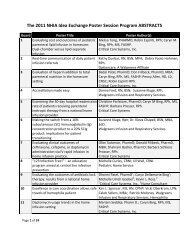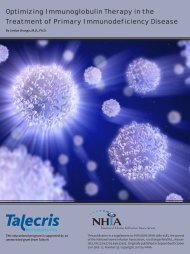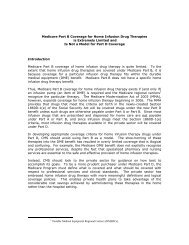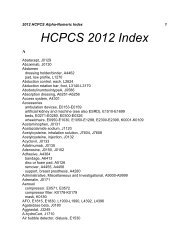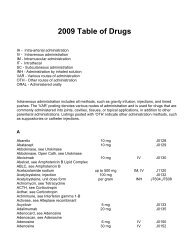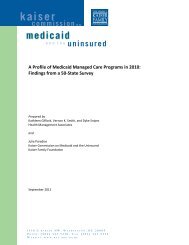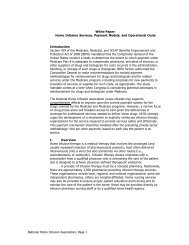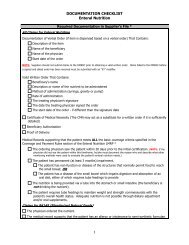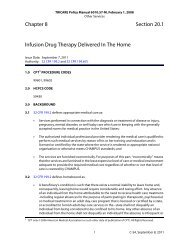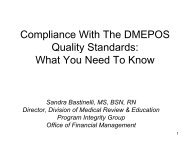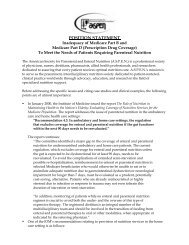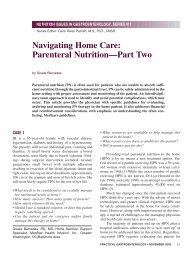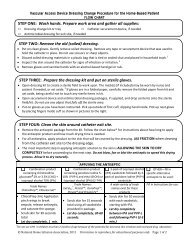IgG Therapy for the Home-Based Patient: Administration and ... - NHIA
IgG Therapy for the Home-Based Patient: Administration and ... - NHIA
IgG Therapy for the Home-Based Patient: Administration and ... - NHIA
You also want an ePaper? Increase the reach of your titles
YUMPU automatically turns print PDFs into web optimized ePapers that Google loves.
able to per<strong>for</strong>m <strong>the</strong>ir own infusions, at home when it’s convenient,<br />
without having to travel to <strong>and</strong> from a treatment center.<br />
A 2010 study showed that patients preferred SCIG over IVIG<br />
<strong>the</strong>rapy (92%) <strong>and</strong> home <strong>the</strong>rapy over <strong>the</strong>rapy at <strong>the</strong><br />
clinic/physician (83%). 12<br />
Un<strong>for</strong>tunately, patients requiring higher <strong>IgG</strong> doses, such as<br />
those with autoimmune diseases, may not be appropriate<br />
c<strong>and</strong>idates <strong>for</strong> SCIG <strong>the</strong>rapy due to <strong>the</strong> large volume of fluid<br />
that would need to be delivered. This is especially true <strong>for</strong> patients<br />
on <strong>for</strong>mulations with comparatively lowerconcentration<br />
<strong>IgG</strong> (i.e. 10% vs 16% or 20%). Similarly, patients who are<br />
very lean may not be suitable c<strong>and</strong>idates <strong>for</strong> SCIG because<br />
<strong>the</strong>y often have limited appropriate sites <strong>for</strong> SC access.<br />
For SCIG to be successful, patients <strong>and</strong> caregivers must<br />
be committed to learning <strong>and</strong> adapting to selfcare. They<br />
should also have a demonstrated history of <strong>the</strong>rapy compliance.<br />
Independence is typically achieved after two to four<br />
nurse teaching visits with continued clinical monitoring <strong>and</strong><br />
patient followup.<br />
Dosing <strong>and</strong> Conversion to SCIG<br />
Several studies demonstrate favorable improvement in infection<br />
rates, hospital admissions, <strong>and</strong> overall morbidity <strong>for</strong> patients<br />
on SCIG. 7,1316 But, how much <strong>IgG</strong> is needed to achieve<br />
<strong>the</strong>se results, <strong>and</strong> what is <strong>the</strong> best dosing strategy <strong>for</strong> patients<br />
just starting SCIG <strong>the</strong>rapy <strong>and</strong>/or converting from IVIG?<br />
Not all patients respond <strong>the</strong> same way to <strong>the</strong> many <strong>IgG</strong> <strong>for</strong>mulations<br />
on <strong>the</strong> market. Differences in pH, osmolarity,<br />
amount of sucrose, <strong>and</strong> amount of IgA, make product selection<br />
very individualized. Similarly, <strong>the</strong>re is no cookie cutter<br />
<strong>for</strong>mula <strong>for</strong> dosing—although higher doses are beginning to<br />
be supported in <strong>the</strong> literature as offering improved clinical<br />
benefits <strong>and</strong> quality of life <strong>for</strong> patients. 17<br />
Unlike IVIG, SCIG doesn’t immediately enter <strong>the</strong> circulatory<br />
system during administration. For this reason, it has a<br />
lower systemic bioavailability <strong>and</strong> more stable serum levels<br />
following administration. Weekly administration of SCIG<br />
leads to stable steadystate serum <strong>IgG</strong> levels with lower<br />
peak levels <strong>and</strong> higher trough levels compared to monthly<br />
IVIG treatment (see Exhibit 2). The FDA recognized this difference<br />
<strong>and</strong> adjusted dosing to achieve a similar “area under<br />
<strong>the</strong> curve” (AUC) by using a productspecific multiplier <strong>for</strong><br />
calculating dosages. Formulas <strong>for</strong> converting IVIG doses are<br />
provided in package inserts <strong>and</strong> available from <strong>IgG</strong> manufacturers<br />
online (see Exhibit 3).<br />
The optimal dose of <strong>IgG</strong> <strong>for</strong> primary immune deficiency was<br />
considered to be 400800 mg/kg/month (100200<br />
mg/kg/week <strong>for</strong> SCIG) with <strong>the</strong> goal of achieving serum levels<br />
of 500 mg/dL or greater. 18,19 But, in 2006, <strong>the</strong> PID Committee<br />
of <strong>the</strong> AAAAI issued a report in which it asserted that <strong>the</strong><br />
dose of <strong>IgG</strong> should be titrated to achieve a trough level<br />
greater than 500 mg/dL in agammaglobulinemic patients <strong>and</strong><br />
that trough levels greater than 800 mg/dL have <strong>the</strong> potential<br />
to improve pulmonary outcomes. 3 This was fur<strong>the</strong>r demonstrated<br />
in a 2010 metaanalysis of PIDD patients on IVIG <strong>the</strong>rapy<br />
<strong>and</strong> experiencing pneumonia, whose rates of infection<br />
were reduced by increasing <strong>the</strong> <strong>IgG</strong> trough levels to midnormal<br />
range (1,000 mg/dL). 17 A subsequent study, published in<br />
2012, examined a broader set of outcomes <strong>and</strong> also favored<br />
higher doses of <strong>IgG</strong>. Researchers comparing results from two<br />
parallel clinical studies found that PIDD patients who maintained<br />
a higher mean <strong>IgG</strong> dose (1.5 times higher) had significantly<br />
lower rates of nonserious infections, hospitalization,<br />
antibiotic use, <strong>and</strong> missed work/school activity. In addition,<br />
<strong>the</strong> higherdose group experienced lower health care utiliza<br />
Exhibit 2<br />
Subcutaneous Versus Intravenous<br />
Serum Ig levels<br />
Total <strong>IgG</strong><br />
1600<br />
1400<br />
1200<br />
1000<br />
800<br />
600<br />
400<br />
Intravenous Ig<br />
Subcutanenous Ig<br />
0 2 4 6 8 10 12 14 16 18 20 22<br />
Days<br />
Source: P&T Product Profiler – Hizentra Vol. 35, Issue 8 /<br />
August 2010 Section 2 / adapted from Berger 2004. Available<br />
at http://www.ptcommunity.com/ptjournal/fulltext/Profiler_Hizentra/Profiler_Hizentra.pdf<br />
Exhibit 3<br />
FDA-Recommended Dose Conversion<br />
<strong>for</strong> SCIG<br />
• 20% products = IVIG dose (g) x 1.53 / number of<br />
weeks between doses<br />
• 10% products = IVIG dose (g) x 1.37 / number of<br />
weeks between doses<br />
4<br />
<strong>IgG</strong> <strong>Therapy</strong> <strong>for</strong> <strong>the</strong> <strong>Home</strong><strong>Based</strong> <strong>Patient</strong>: <strong>Administration</strong> <strong>and</strong> Delivery Method Considerations



